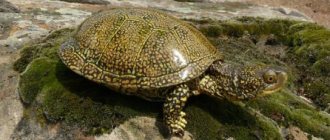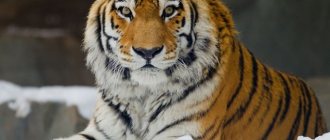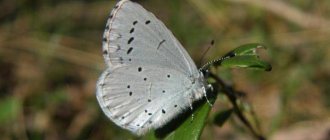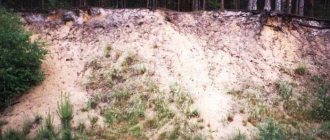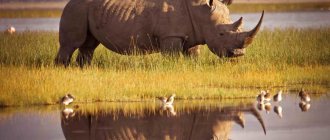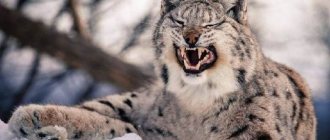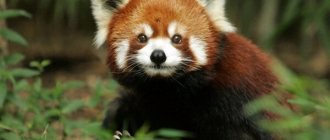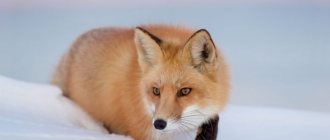Livestock » Sheep
0
2658
Article rating
Kira Stoletova
The mountain sheep Argali is a herbivorous animal from the order of artiodactyls, the family of bovids, and the genus of sheep. It is called ovis in Latin.
Characteristics of the mountain sheep
This ram was first described in the 13th century by the Franciscan monk Wilhelm von Rubruck, who traveled through Mongolia.
Marco Polo saw and described these animals on the palmyra, and in the 18th century, German explorer Johann Georg Gmelin provided detailed data about the Argali under the name Argali, which is consonant with the Mongolian name.
This species is now considered endangered and hunting is prohibited. The Red Book of many countries of Middle, Central and East Asia contains information about Argali.
Description
Photo:
Height at the withers - 70-125 cm, body length - 1.2-2 m, tail length 13-14 cm, body weight - 70-180 kg. Life expectancy is 12-18 years.
As already mentioned, the Altai ram is the largest ram. The height of an adult can reach 125 centimeters and a length of two meters.
These are strong herbivores with corresponding horns. In the Altai ram they are hollow, very wide and wrapped in such a way that the edges stick out forward.
In this case, the main part of the horn is a horn loop facing the back of the animal.
Horns play a big role in the role of a ram. With the help of them, the animal not only protects itself from natural enemies, but also participates in widespread fights during the breeding season.
Like all members of the sheep family, the Altai mountain sheep is a herbivore.
The basis of its diet is a variety of cereals, sedge, buckwheat and other herbs. In winter, in the absence of a proper food supply, animals migrate.
In particular, they descend from the mountains and graze on the plains. To find suitable pasture, the Altai mountain sheep can migrate up to 50 kilometers.
Natural enemies of the mountain sheep
Of the main enemies of argali, wolves occupy the first place in importance. This predator's hunting of bovid-horned artiodactyl mammals causes great damage to the population, since mountain sheep prefer to stay on the most flat and fairly open, as well as clearly visible places.
Also, the number of argali is significantly reduced due to such natural enemies of mountain sheep as snow leopard, leopard, coyote, cheetah, eagle and golden eagle. Among other things, mountain sheep are still very actively hunted by people who kill artiodactyl mammals in order to obtain meat, skins and expensive horns.
Return to content
Habitat
Today there are only three points on the globe where you can see the Altai mountain goat:
- In the Chulshman region;
- In the area of the Sailyugem mountain range;
- On the section between Mongolia and China.
It goes without saying that the places where the sheep live are carefully protected and are a protected area.
The favorite place of mountain goats is mountainous terrain. At the same time, they do not need abundant vegetation - small shrubs from the round-leaved subspecies will be quite enough for them.
In the hot season, mountain sheep can eat two or three times, but as for watering places, the opposite is true - they replenish the water reserves in their bodies once every three days.
Spreading
Argali live in the mountainous and foothill regions of Central and Central Asia at an altitude of 1300-6100 m above sea level[4] - in the Pamirs, the Himalayas, Altai, Sayan Mountains of Mongolia and Tibet. In the past, the range of argali was much wider - in the late Pleistocene and early Holocene they were common animals in the south of Western and Eastern Siberia, south of northern Transbaikalia and southwestern Yakutia.[12] Even in the Bronze Age, it was numerous in Western Transbaikalia, as evidenced by numerous finds of skulls of these animals, including in the burial of the Huns, dating back to the 3rd-2nd centuries BC.[11]
They prefer open spaces - steppe slopes of mountains and foothills with rocks, alpine meadows, rocky gorges overgrown with bushes, valleys with rocky hills. Avoid dense woody vegetation. Migration is vertical - in summer they rise to areas of the alpine belt with rich grassy vegetation, in winter they descend to lower pastures with little snow.
Number
At the beginning of the 20th century, the number of Altai mountain sheep reached 600 individuals. Somewhat later, their number sharply decreased - to 245.
By carrying out conservation measures and relocating adult individuals to protected areas, it was possible to slightly increase the number - up to 320 individuals, including both cubs and adult representatives of this breed.
They tried to breed the breed under artificial conditions - in zoos in Germany and America, but, unfortunately, the attempts were unsuccessful. In most cases, the animals died within a few weeks.
The only long-living animal was the mountain sheep, which was bred at the Biological Institute of Russia - it lived for six years. Obviously, this breed needs to be kept only in natural conditions for them, or at least in as similar conditions as possible.
The Novosibirsk Zoo is engaged in saving the species, as well as serious attempts to increase the population. This institution is the only one in the world where anyone can see Altai mountain sheep. Another interesting fact is that the rams kept here successfully give birth to offspring.
Zoo scientists drew up a plan for raising and releasing young lambs into the wild.
As part of this activity, four males were released into their natural habitat in September 2022 and raised separately in a special enclosure. The event was successful, and the animals went into the forest.
According to experts, they should meet a large herd of wild sheep located in the release area and become part of it.
Interesting fact: Mountain sheep are listed as a vulnerable species in the international Red Book. Also included in the Red Book of Russia.
Population status and species protection
Local hunters shoot mountain sheep en masse for their horns, which are actively used by Chinese traditional medicine healers to prepare various potions. Almost all subspecies of this artiodactyl mammal live in rather inaccessible areas, so it is impossible to accurately control their numbers.
Argali are often forced out of pastures by livestock, after which the fields become completely unsuitable for feeding mountain sheep . The decline in numbers is also extremely negatively affected by climate change, too harsh or very snowy winters.
The Argali or argali mountain sheep is included in the Red Book of the Russian Federation, and this makes it possible to bring to justice those who illegally hunt the endangered artiodactyl. As practice shows, argali can be tamed, and for comfortable keeping in captivity, it is enough for such a bovid mountain sheep to be allocated a spacious enclosure with a high and strong fence, as well as a room with drinking bowls and feeders. To restore the species' numbers, endangered animals are also placed in special protected areas and kept in zoos.
Return to content
Breeding
They tried to breed the described species in zoos in Germany and America, but the animals always died after living for several months, or even days. The longest a representative of the Argali genus lived in captivity was 6 years at the Biological Institute of Siberia, Russia.
Obviously, mountain sheep should be kept close to their natural habitat or similar conditions should be created and good care should be provided.
Rocks stick together, forming large herds. Females always walk alone. Males always try to move in such a way as to be able to protect their females and cubs in any situation.
Usually the mating season begins in November, the female carries the cubs for 5 months, and already in early May gives birth to only one lamb. Argali lambs are born completely independent and immediately stand on their feet.
Reproduction and offspring
Shortly before mating, mountain sheep unite into small herds consisting of a maximum of fifteen animals. Sexual maturity in female argali occurs already in the second year of life, but animals acquire the ability to reproduce only at the age of two years. A male mountain sheep becomes sexually mature by the age of two, but the animal takes an active part in reproduction much later, from about five years of age.
Until this age, young males are constantly driven away from females by their older and larger brothers. The timing of the onset of the active rut is not the same in different parts of the mountain sheep's range. For example, for individuals living in Kyrgyzstan, the rutting season is usually observed in November or December. A characteristic feature of adult male rams is the ability to create for themselves so-called “harems” consisting of eight or more females. The maximum number of females per mature male mountain sheep is about twenty-five individuals.
Along with females, such a herd may include several immature animals. Sexually mature, but not yet strong enough, young males of such bovid artiodactyls, not allowed to approach the females by the strongest and most developed rivals, during the rutting period most often unite into separate small groups that wander not far from the created “harems”.
During the mating season, argali males are characterized by strong arousal and very actively chase after sexually mature females, as a result of which they become less cautious. It is during such a period that it is absolutely no difficulty for hunters and predators to approach artiodactyls at a dangerous distance. Numerous tournament fights take place between adult males and males ready for mating during the rutting season, during which the animals disperse and come together again, hitting their foreheads and the bases of their horns with incredible force as they run.
This is interesting! Loud sounds accompanying such impacts can be heard in the mountains even at a distance of several kilometers. After the rutting season is over, the argali males again separate from all the females and, uniting in small groups, climb the mountains.
The gestation period of a female argali is approximately five or six months, after which lambs are born with the onset of spring warmth. Before the onset of lambing, female mountain sheep move away from the main herd and look for the most remote rocky or dense bush areas for lambing. As a result of lambing, as a rule, one or two lambs are born, but there are also cases of triplets being born.
The average weight of newborn lambs directly depends on their number, but most often does not exceed 3.5-4.5 kg. Signs of sexual dimorphism, in terms of weight, at birth are very weakly expressed. Newborn females may be slightly smaller than males. In the very first days of life, newborn lambs are quite weak and absolutely helpless. They hide between large stones or in bushes. Around the third or fourth day, the lambs become more active and follow their mother.
If in the first days, all lambing female mountain sheep prefer to stay alone, then after a couple of weeks, after the offspring get a little stronger, they begin to wander and even unite in small groups. Such small herds of females are subsequently also joined by last year’s young. Mother's milk is used as the main feed for mountain sheep lambs until about mid-autumn. This healthy and highly nutritious product in its chemical composition and taste characteristics does not differ significantly from domestic sheep's milk.
Lambs begin to consume green food to a limited extent a few weeks after birth, and with the onset of autumn, a significant part of the young feed on their own. Females, as they grow and develop, noticeably lag behind males in size.
This is interesting! Mountain argali grow quite slowly and for a long time, and the slow growth is especially noticeable in males, who can gradually increase in size almost throughout their entire life.
Return to content
What is WWF doing to conserve the argali?
All argali groups in our country are concentrated on the border with Mongolia. Argali is a migratory species, animals are constantly moving from one country to another, so censuses of argali numbers and environmental measures are carried out simultaneously on both sides of the border.
Every year, specialists from Russia and Mongolia organize joint censuses of the argali population, clarify the boundaries of the groups’ habitats, and adjust environmental plans depending on the results.
WWF and partners first monitored the number of argali in 2003, estimating the number of argali in the transboundary territory between Russia, Mongolia and Kazakhstan at 1080-1170 individuals.
As part of the Foundation’s work, a project for the conservation of argali has been launched in the Altai-Sayan ecoregion, which involves the involvement of the border service, the creation of new protected areas and anti-poaching groups.
In 2011, WWF experts prepared a “Program for monitoring the Altai mountain sheep argali in the transboundary zone of Russia and Mongolia.”
In 2014, the results of a census of the transboundary population of the Altai mountain sheep showed a 23% increase in numbers over two years.
In total, experts counted 2,400 individuals in Russia and Mongolia. In 2015, for the first time in many years, argali were captured by camera traps on the Tsagan-Shibetu ridge in Tuva. This fact is unique, since it was believed that argali are extremely rare in this part of Tuva, and the range of the mountain sheep is shrinking.
Based on the results of surveys in 2016, it was revealed that 1198–1199 argali individuals live in Russia. Of these, 1,168 argali are in the Altai Republic (838 in the Sailyugemsky National Park, 330 individuals on the Chikhachev Ridge, Altai Mountains), 30 argali are in the Republic of Tuva.
The total number of a single group on the border of Russia and Mongolia is 3898–3899 animals.
The main threat to the existence of argali in Tuva, as well as in Russia as a whole, is poaching. Argali are shot for a trophy - the horns of males and for food.
WWF has been working on the conservation of argali in Russia for many years. The Foundation promotes anti-poaching activities, organization of international Russian-Mongolian research and registration of argali.
WWF specialists participate in the development of materials for official programs for the protection of the species in our country and in the creation of protected areas in the argali habitats.
Since 2003, according to WWF records, the number of argali in the transboundary zone of Russia and Mongolia has remained stable.
Excerpt characterizing Argali
The case was presented by those offended in such a way that, after the transport was recaptured, Major Denisov, without any summons, came to the chief of provisions in a drunken state, called him a thief, threatened him with beatings, and when he was taken out, he rushed into the office and beat up two officials and sprained one's arm. Denisov, in response to Rostov’s new questions, laughingly said that it seemed like someone else had turned up here, but that it was all nonsense, nonsense, that he didn’t even think of being afraid of any courts, and that if these scoundrels dare to bully him, he would answer them so that they will remember. Denisov spoke disparagingly about this whole matter; but Rostov knew him too well not to notice that in his soul (hiding it from others) he was afraid of the trial and was tormented by this matter, which, obviously, was supposed to have bad consequences. Every day, requests for papers and demands to the court began to arrive, and on the first of May Denisov was ordered to surrender the squadron to his senior man and appear at the division headquarters for explanations in the case of rioting in the provisions commission. On the eve of this day, Platov made reconnaissance of the enemy with two Cossack regiments and two squadrons of hussars. Denisov, as always, rode ahead of the line, flaunting his courage. One of the bullets fired by the French riflemen hit him in the flesh of his upper leg. Maybe at another time Denisov would not have left the regiment with such a light wound, but now he took advantage of this opportunity, refused to report to the division and went to the hospital. In June, the Battle of Friedland took place, in which the Pavlograd residents did not participate, and after it a truce was declared. Rostov, who deeply felt the absence of his friend, having had no news about him since his departure and worrying about the progress of his case and his wounds, took advantage of the truce and asked to go to the hospital to visit Denisov. The hospital was located in a small Prussian town, twice devastated by Russian and French troops. Precisely because it was in the summer, when it was so nice in the field, this place, with its broken roofs and fences and its dirty streets, ragged inhabitants and drunken and sick soldiers wandering around it, presented a particularly gloomy sight. In a stone house, in a courtyard with the remains of a dismantled fence, some broken frames and glass, there was a hospital. Several bandaged, pale and swollen soldiers walked and sat in the courtyard in the sun. As soon as Rostov entered the door of the house, he was overwhelmed by the smell of a rotting body and a hospital. On the stairs he met a Russian military doctor with a cigar in his mouth. A Russian paramedic followed the doctor. “I can’t burst,” said the doctor; - Come to Makar Alekseevich in the evening, I’ll be there. – The paramedic asked him something else. - Eh! do as you please! Doesn't it matter? - The doctor saw Rostov climbing the stairs. - Why are you here, your honor? - said the doctor. - Why are you here? Or the bullet didn’t kill you, so you want to get typhus? Here, father, is the house of lepers. - From what? - asked Rostov. - Typhus, father. Whoever rises will die. Only the two of us with Makeyev (he pointed to the paramedic) are chatting here. At this point, about five of our brother doctors died. “As soon as the new one arrives, he’ll be ready in a week,” the doctor said with visible pleasure. “They called Prussian doctors, because our allies don’t like that.” Rostov explained to him that he wanted to see the hussar major Denisov lying here. - I don’t know, I don’t know, father. Just think, I have three hospitals for one person, 400 patients are too many! It’s also good, the Prussian ladies who are benefactors send us coffee and lint at two pounds a month, otherwise they would be lost. - He laughed. – 400, father; and they keep sending me new ones. After all, there are 400? A? – he turned to the paramedic. The paramedic looked exhausted. He was apparently waiting with annoyance to see how soon the chattering doctor would leave. “Major Denisov,” Rostov repeated; – he was wounded near Moliten. - It seems he died. Eh, Makeev? – the doctor asked the paramedic indifferently. The paramedic, however, did not confirm the doctor’s words. - Why is he so long and reddish? - asked the doctor. Rostov described Denisov's appearance. “There was, there was one,” the doctor said as if joyfully, “this one must have died, but I can handle it, I had the lists.” Do you have it, Makeev? “Makar Alekseich has the lists,” said the paramedic. “Come to the officers’ chambers, you’ll see for yourself there,” he added, turning to Rostov. “Eh, it’s better not to go, father,” said the doctor, “otherwise you might end up staying here.” “But Rostov bowed to the doctor and asked the paramedic to accompany him. “Don’t blame me too much,” the doctor shouted from under the stairs. Rostov and the paramedic entered the corridor. The hospital smell was so strong in this dark corridor that Rostov grabbed his nose and had to stop to gather his strength and move on. A door opened to the right, and a thin, yellow man, barefoot and wearing only underwear, leaned out on crutches. He leaned against the lintel and looked at those passing by with shining, envious eyes. Looking through the door, Rostov saw that the sick and wounded were lying there on the floor, on straw and overcoats. -Can I come in and have a look? - asked Rostov. - What should I watch? - said the paramedic. But precisely because the paramedic obviously did not want to let him in, Rostov entered the soldiers’ chambers. The smell he had already smelled in the corridor was even stronger here. This smell has changed somewhat here; he was sharper, and one could feel that this was where he came from. In a long room, brightly lit by the sun through large windows, the sick and wounded lay in two rows, with their heads to the walls and leaving a passage in the middle. Most of them were in oblivion and did not pay attention to those who entered. Those who were in memory all stood up or raised their thin, yellow faces, and all with the same expression of hope for help, reproach and envy of other people's health, without taking their eyes off, looked at Rostov. Rostov went out into the middle of the room, looked into the neighboring rooms with open doors, and saw the same thing on both sides. He stopped, silently looking around him. He never expected to see this. In front of them lay almost across the middle aisle, on the bare floor, a sick man, probably a Cossack, because his hair was cut into a brace. This Cossack was lying on his back, with his huge arms and legs outstretched. His face was crimson red, his eyes were completely rolled back, so that only the whites were visible, and on his bare feet and on his hands, still red, the veins were strained like ropes. He hit the back of his head on the floor and said something hoarsely and began to repeat the word. Rostov listened to what he was saying and made out the word he was repeating. The word was: drink - drink - drink! Rostov looked around, looking for someone who could put this patient in his place and give him water. -Who takes care of the sick here? – he asked the paramedic. At this time, a Furstadt soldier, a hospital attendant, came out of the next room and stood up in front of Rostov with a beating step. - I wish you good health, your honor! – this soldier shouted, rolling his eyes at Rostov and, obviously, mistaking him for the hospital authorities. “Take him away, give him water,” said Rostov, pointing to the Cossack. “I’m listening, your honor,” the soldier said with pleasure, rolling his eyes even more diligently and stretching out, but without moving from his place. “No, there’s nothing you can do here,” Rostov thought, lowering his eyes, and was about to leave, but on the right side he felt a significant gaze directed at himself and looked back at him. Almost in the very corner, sitting on an overcoat with a thin, stern face, yellow as a skeleton, and an unshaven gray beard, sat an old soldier and stubbornly looked at Rostov. On the one hand, the old soldier’s neighbor whispered something to him, pointing at Rostov. Rostov realized that the old man intended to ask him for something. He came closer and saw that the old man had only one leg bent, and the other was not at all above the knee. Another neighbor of the old man, lying motionless with his head thrown back, quite far from him, was a young soldier with a waxy pallor on his snub-nosed face, still covered with freckles, and his eyes rolled back under his eyelids. Rostov looked at the snub-nosed soldier, and a chill ran down his spine. “But this one, it seems...” he turned to the paramedic. “As asked, your honor,” said the old soldier with a trembling lower jaw. - It ended this morning. After all, they are also people, not dogs... “I’ll send it now, they’ll clean it up, they’ll clean it up,” the paramedic said hastily. - Please, your honor. “Let’s go, let’s go,” Rostov said hastily, and lowering his eyes and shrinking, trying to pass unnoticed through the ranks of those reproachful and envious eyes fixed on him, he left the room. Having passed the corridor, the paramedic led Rostov into the officers' quarters, which consisted of three rooms with open doors. These rooms had beds; wounded and sick officers lay and sat on them. Some walked around the rooms in hospital gowns. The first person Rostov met in the officers' quarters was a small, thin man without an arm, in a cap and hospital gown with a bitten tube, walking in the first room. Rostov, peering at him, tried to remember where he saw him. “This is where God brought us to meet,” said the little man. - Tushin, Tushin, remember he took you near Shengraben? And they cut off a piece for me, so...,” he said, smiling, pointing to the empty sleeve of his robe. – Are you looking for Vasily Dmitrievich Denisov? - roommate! - he said, having found out who Rostov needed. - Here, here, and Tushin led him into another room, from which the laughter of several voices was heard. “And how can they not only laugh, but live here?” thought Rostov, still hearing this smell of a dead body, which he had picked up in the soldier’s hospital, and still seeing around him these envious glances that followed him from both sides, and the face of this young soldier with his eyes rolled up. Denisov, covering his head with a blanket, slept in bed, despite the fact that it was 12 o'clock in the afternoon. - Eh, G'ostov? “It’s great, it’s great,” he shouted in the same voice as he did in the regiment; but Rostov noticed with sadness how, behind this habitual swagger and liveliness, some new bad, hidden feeling was visible in Denisov’s facial expression, intonations and words.
Peregrine Falcon
The peregrine falcon belongs to the falcon family. It is believed to be the fastest living creature on the planet. Capable of reaching speeds during a diving flight of over 300 km/h. During a hunt, he hits his prey with his paws at full falling speed so much that even a large game's head can be torn off. It is also endangered due to pesticides that are sprayed on trees and fields.
Unfortunately, the Red Book of the Arkhangelsk Region, where animals and plants are numerous, does not guarantee their safety, but all residents of the region should become familiar with endangered species.
Red-throated loon
The Red Book of the Arkhangelsk Region includes insects, fish, and birds in its lists. The Red-throated Loon is a small and very attractive bird, so named because it has a bright red spot on its neck.
This migratory bird prefers not the sea coast, like its other relatives, but rivers and the tundra zone. She flies very quickly, taking off vertically right out of the water, but on land she is practically helpless and walks with difficulty, sometimes she simply crawls, helping herself with her flippers. In her native element, she dives deep for prey, which is fish. As an additional food it can eat mollusks, crustaceans and aquatic insects.
For the sake of its feathers and fluff, people have put this bird in danger of extinction. Today the population in the Arkhangelsk region is gradually growing, perhaps in some foreseeable future it will be removed from the list of rare species.
Nutrition
Wild mountain sheep argali belong to the category of herbivores, which is why the main diet of artiodactyls consists of diverse, herbaceous vegetation, which is characteristic of the area and region in which the subspecies exists. According to numerous scientific observations, bovid argali prefer cereals to any other type of plant food.
This is interesting! All subspecies are unpretentious, therefore, in addition to cereals, they eat sedge and saltwort with great pleasure and in large quantities.
The artiodactyl mammal is not at all afraid of bad weather and precipitation, so it actively eats succulent vegetation even during fairly heavy rains. The presence of water for a mountain sheep is not a daily necessity of life, so such an animal can quite easily not drink for a long time. If necessary, argali are able to drink even salt water.
